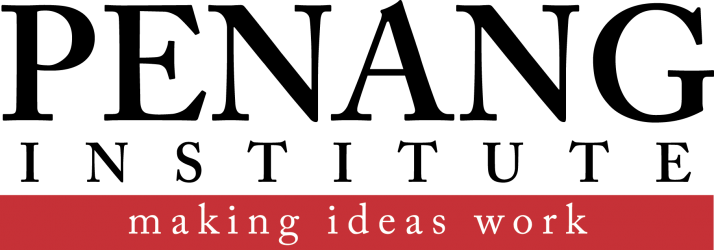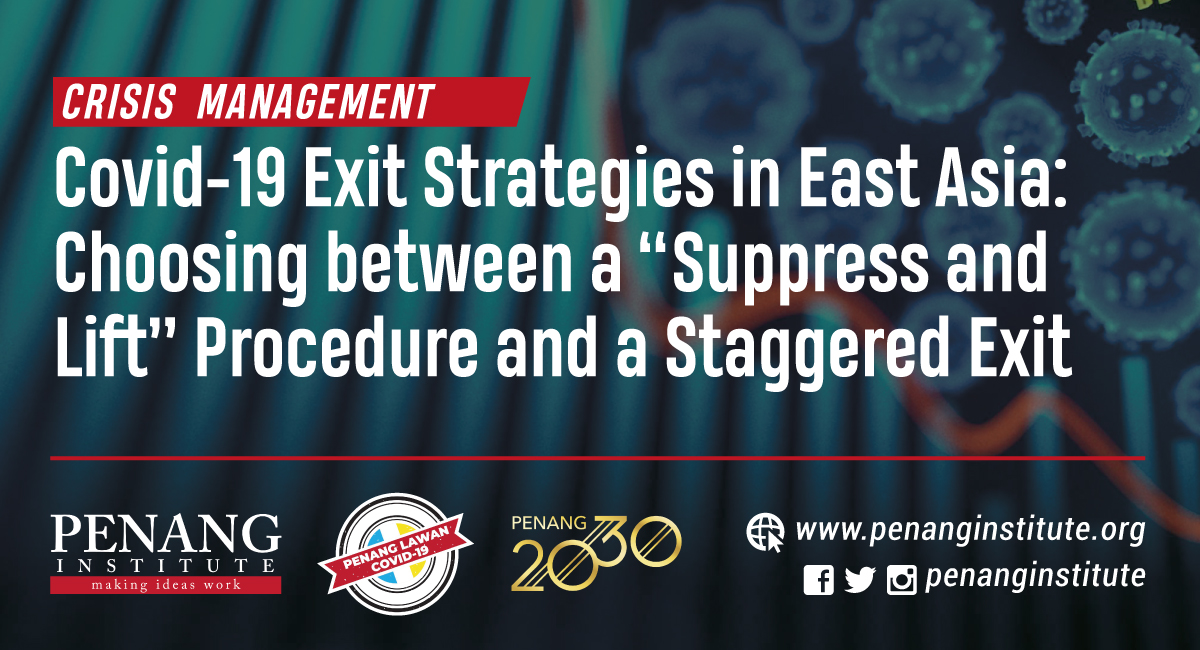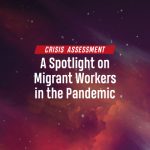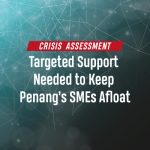EXECUTIVE SUMMARY
- After months of partial lockdown to contain the spread of Covid-19, many East Asian countries and territories have begun to ease restrictions to reactivate the economy.
- On one hand, while places like Hong Kong, China and South Korea engaged in a “suppress and lift” strategy, others like Malaysia and Singapore adopted a phase-by-phase exit strategy. The combination of such exit strategies is likely to continue in the near future.
- The immediate challenge lies in balancing between epidemic prevention and economic reactivation. Major factors in this context include the degree of public compliance and adoption of technology.
- Until a vaccine is invented, collective responsibility is critical in the protracted battle against the Covid-19 virus.
INTRODUCTION
After months of partial lockdown to contain Covid-19, governments around the world are cautiously working out an exit strategy. Yet, as long as an effective vaccine is absent, it is almost impossible for the public to go back to the lives they once saw as normal lives. This will mean that exit strategies remain merely a modification of the measures introduced during the partial lockdown.
While it is hard for every country or territory to adopt a similar standard for an exit strategy, the six criteria devised by the World Health Organization (WHO) can act as a reliable benchmark, at least for when such a move may begin:
1. When transmission is controlled;
2. When health system capacities are in place to detect, test, isolate, treat every case and conduct contact tracing;
3. When outbreak risks are minimized in settings like nursing homes and health facilities;
4. When preventive measures are in place in workplaces, schools and other essential locations;
5. When importation risks can be managed;
6. When communities are fully educated, engaged and empowered to adjust to the “new norm”
This paper will examine the exit strategies of a few East Asian countries and territories. It then looks at the immediate challenges, and follows with some policy recommendations.
TAIWAN AND SOUTH KOREA
South Korea and Taiwan’s deft handling of the Covid-19 has been lauded primarily because both of them had learned their lessons the hard way. South Korea learned from its traumatic experience dealing with the Middle East Respiratory Syndrome (MERS) in 2015[1] while Taiwan learned from dealing with the SARS pandemic in 2003.
In handling Covid-19, Taiwan did not engage in a full nor a partial lockdown to contain the virus while South Korea only confined its partial lockdown to Daegu, the epicenter of the coronavirus outbreak. As such, it is hard to precisely measure when the exit strategy of these polities truly began. Even so, the experience in these two territories suggest that it is best to take a cautious approach.
South Korea did not immediately ease its regulations despite a steady decline in the infectivity rate beginning in March. The government continued to urge the public to work from home and to maintain social distancing. It finally began to ease its restriction in early May after a sharp decline in the number of cases, but faced a new cluster at some nightclubs soon after.[2] An asymptomatic patient had frequented a few clubs in Seoul. The government immediately shut down all nightclubs temporarily and closed schools, art galleries, museums and theatres again.
The South Korean government also urged those who were exposed to get themselves tested and to quarantine themselves. But this is where another set of problems began. The new cluster that emerged in South Korea is linked to the city’s gay scene. The conservative culture in Korea has yet to openly accept the LGBT community, and patrons of the gay clubs who were at risk were reluctant to come out to get tested, for fear of a moral backlash. This made contact tracing much more difficult. And when the government attempted to trace them, many either did not answer their phones or it turned out that they had been providing false numbers.[3]
The South Korean case illustrates that although a cautious approach is helpful in containing Covid-19, one cannot rule out a reintroduction of a partial lockdown when new clusters emerged.
Similarly, Taiwan’s comprehensive strategy in managing the public health crisis came out of the harsh lesson learned from the SARS pandemic in 2003. After that outbreak, Taiwan established the Central Epidemic Command Center that could immediately put together a checklist of 124 “action items” which were implemented over a five-week period.[4] It was the first territory to stop travelers from Wuhan crossing its borders. The quarantine of suspected cases and Taiwanese returnees were strictly monitored, and the government took efforts to communicate to the public that there was no stigma in contracting the virus and has been supportive of patients as well as those under quarantine. The containment strategy had proven effective and Taiwan had managed to keep its coronavirus infection numbers at a minimal.
What also sets South Korea and Taiwan apart from other territories is that the public was willing to comply. It can be argued that the South Korean and the Taiwanese governments enjoyed the public’s trust in facing the pandemic.
Given that Taiwan has been able to minimize the disruption to the daily lives of the people, it is more apt to describe its government as having an effective containment strategy rather than an actual exit strategy. It continues taking a very cautious approach, and is still reluctant to engage in a broad lifting of border controls. Instead, the Taiwanese government is only considering opening its borders to movements affecting important sectors such as the electronic manufacturing sector.[5] The state recognizes that as long as the number of cases in Europe and America remain high, imported cases remained a serious cause for concern.
HONG KONG AND CHINA
As with Taiwan, Hong Kong’s experience with SARS prepared the city to face Covid-19. It is also hard to gauge when the exit strategy in Hong Kong began because the territory engaged in a “hammer and dance” or “suppress and lift” strategy rather than in a clearly defined exit strategy; the government tighten measures when the infectivity rate is high and ease the measures when the infectivity rate is low.[6] Hong Kong’s strict measures include imposing electronic tagging of new arrivals and compelled them to quarantine for 14 days. The police force also patrol the night clubs to identify those who violate quarantine.[7] However, when cases drop, schools and some public places reopen. Hong Kong expects this “hammer and dance” strategy to continue over the next two years.
On the other hand, Mainland China’s exit strategy is a national whack-a-mole strategy.[8] When there is risk of a rise in the infectivity rate in a specific part of China, the Chinese government imposes strict lockdown restrictions and only eases them after the number of cases is under control. For instance, when 13 cases were found in Shulan, a city close to the border with North Korea and Russia, partial lockdown measures were introduced. Most public facilities were shut down and only a representative from one household was allowed to purchase groceries. Similar restrictions were also imposed in Harbin when the city reported imported cases.[9] Such ongoing national scale whack-a-mole method is likely to persist in China as the country battles Covid-19.
MALAYSIA AND SINGAPORE
In turn, Malaysia and Singapore took a staggered approach by easing restrictions gradually. For instance, Malaysia’s Health Director-General Dr. Noor Hisham has persistently said that in the fight against Covid-19, a soft-landing approach is necessary – a staggered reopening instead of a sudden lift of all restrictions.
The Conditional Movement Control Order (CMCO), a more relaxed version of the Movement Control Order (MCO) was an initial step in its exit strategy. Apart from economic activities that require close contact such as hairdressing and beauty and spa services (which were only allowed to resume on 10 June), most economic activities in Malaysia were resumed under CMCO. However, schools and tertiary education institutions remained closed. Group activities were regulated and celebrations of any sort discouraged. Even inter-state travelling required police permission. Under CMCO, there were also strict SOPs for the public to follow in all public places. For example, temperature screening and registration in public places, regular disinfection and social distancing are now the regulations that Malaysians have to get used to. Besides, authorities in Malaysia continue to patrol the compliance of the public.
As cases declined, the Recovery Movement Control Order (RMCO) finally began on 10 June, to last till 31 August. Under RMCO, more economic activities are allowed as is inter-state travelling. However, the SOP introduced in the earlier phase remains. The general public has to continue to live with some degree of restrictions.
What Singapore has been doing is to ease lockdown measures in three phases. The first phase began when the “Circuit Breaker” ended on June 2, and 75 percent of the economy resumed operations.[10] More relaxation measures such as small-group dining-in, opening of stadiums and swimming pools are expected in the next two phases, on the caveat that cases do not suddenly spike exponentially. The Covid-19 regulations, published in the Government Gazette, continue to be in force indefinitely. Among others, social distancing, mask-wearing and restricted numbers at social gatherings or for family visits continue.[11] Singapore is also very strict in policing its citizens to follow the law.
However, community cases (widely believed as cases of local transmission) have steadily increased in the post-circuit breaker phase.[12] Despite the strict regulations, the challenge to contain Covid-19 still persists. Should cases increase, one cannot rule out that Singapore will re-introduced the circuit-breaker.
In a gist, Malaysia and Singapore are taking a staggered approach in their exit strategy. The RMCO in Malaysia and the post-circuit breaker in Singapore are a gradual relaxation to let the society regain a semblance of normalcy. By and large, this is a slow-and-steady approach.
At present, both countries are still challenged by the transmissions among foreign workers and migrants, and by sporadic cases of local transmissions. While Malaysia wrestles with new clusters in detention centres, Singapore has to manage the health of the tens of thousands migrant workers who have been infected with Covid-19. Perhaps, it is not going too far to posit that intermittent cases of local cases alongside clusters of infection among those who stay in crowded spaces is the new normal as long as no vaccine against Covid-19 appears.
Notwithstanding the relative success of the exit strategy of these areas, the battle against Covid-19 cannot be over until it is really over. After all, the ebbing of cases in one country could happen at the same as another country is experiencing a rise in its cases. Beyond imported cases, the risk of local transmission persists. A case in point is South Korea where it only took one patient to create a new cluster after months of relative success in keeping the disease under control. In Singapore, a city-state where many take public transport, the risk of local transmission remains high,
Therefore, until and unless a vaccine is found, the alleged exit strategy in East Asia will be through a “suppress and lift” method or through a staggered opening, or a combination of both. What is certain for most East Asian countries is that some of the restrictions imposed during the partial lockdown will remain. Also, intermittent cases have to be expected. The following section will discuss some challenges facing exit strategies, and provide some recommendations.
CHALLENGES TO AN EXIT STRATEGY AND SOME RECOMMENDATIONS
Voluntary compliance
A sustainable exit strategy is conditioned on the voluntary public compliance. However, members of the public tend to get complacent once regulations are relaxed. Cases can surge again if there is no collective co-operation. Voluntary compliance, it should be noted, is preceded by efforts to supply the public with knowledge of risks and of protective measures they can take at the individual level. Thus, regular press releases and clear and updated information from the respective Health Ministry are necessary.
In addition, trust in healthcare professionals and authorities is also vital, and voluntary compliance can only be gained when the public is convinced that the government is handling the health crisis well. While hard-handed measures deter the public from flouting the law, a dose of compassion like the example of Taiwan can go a long way. This will encourage those who are exposed to risks to be more willing to come forward to be tested.
Crowded Spaces
Crowded spaces will remain high-risk for transmissions. Examples include the living conditions of the hardcore poor, the migrant workers, and refugees. Apart from that, detaining and retirement centres remain vulnerable spots for transmission. But the issue of space is an entrenched challenge. It is not an issue that can be solved over a short span of time. Providing spacious areas for vulnerable communities will require concerted efforts from society and a lot of resources. At best, these vulnerable groups can in the short term protect themselves by minimizing social interaction with people that are not from their households, clean their hands and their living space regularly and stay home as much as they can.
In this respect, NGOs and private companies can do their part to help by raising funds to provide hand sanitizers, soaps and disinfectants, as well as face masks for these communities.
Use of Technology and the Lack of it
One explanation for the East Asian success in containing the pandemic is in their application of digital technology. Taiwan, South Korea, and Singapore tapped into granular geographical information for effective contact tracing. The Singapore government also encouraged its citizens to install TraceTogether, which exchanges Bluetooth signals between mobile phones in close proximity. Adopting technology for contact tracing is certainly much more efficient than if contact tracing were done manually.
However, not all countries enjoy such high technology, and not everyone can afford a smartphone in order to participate in a high-tech Covid-19 containment strategy. Another challenge that comes with this kind of contact tracing is that it requires the willingness of the citizens to install the app.
The alternative is to enforce manual tracing. But the challenge there is that there may be people who may not wish to disclose their actual personal information. When there is an absence of cases, this is not an issue. However, should there be a spike of cases, gaps in contact tracing can cost precious time in stopping the spread of the disease.
Governments can only encourage its citizens to download the tracking apps and ensure that authentic information has been provided if the tracing is done manually. The idea that fighting the disease is a collective responsibility has to be drummed into the public. At the same time, the public also has to be reassured that their personal details will not be compromised. In this regard, laws to punish people who steal and abuse the personal information of others should be introduced.
OF IMPORTED CASES AND THE OPENING OF BORDERS
Even as cases dip in many East Asian territories, they continue to soar elsewhere. As such, there are serious concerns about border control. It is quite impossible for countries to close their borders indefinitely. The tourism industry and the aviation industry have already been badly affected and the unemployment rate is rising. Another reason that necessitates the opening of aviation routes is that there are cases of family members remaining separated in different territories or being stranded in a foreign land.
One cautious way for East Asian countries to act would be for them to open their borders for travelers from countries that have shown success in controlling Covid-19 and have been transparent in reporting their cases. Airports should continue to screen travelers and designate some space as temporary isolation rooms for suspected cases. Upon arrival, travelers who show symptoms of Covid-19 should be isolated immediately. Alternatively, mandatory self-quarantine of 14 days can be implemented, as is already being enforced by many countries. Updated information of Covid-19, local regulations, and hotlines should be accessible to travelers, too. Travelers should be briefed during their flight about what is expected of them on arrival, and be informed with leaflets of some sort when they reached their destination.
CONCLUSION
To reiterate, a comprehensive exit strategy can only happen when there is a vaccine. Until then, adjustment is all that can be done. In the immediate future, a combination of “suppress and lift” and a staggered exit is probably how East Asia will battle with the pandemic. The good news is that with slightly better understanding of the virus, these countries and territories can be better prepared. Indeed, the battle against Covid-19 is not over yet. Even as cases plateau in East Asia, they remain high in numbers in the West. Public compliance is critical; the onus is therefore on everyone.
[1] Kim H.J. 2020. “South Korea learned its successful Covid-19 strategy from a previous coronavirus outbreak: MERS”, Bulletin of the Atomic Scientists, https://thebulletin.org/2020/03/south-korea-learned-its-successful-covid-19-strategy-from-a-previous-coronavirus-outbreak-mers/ (accessed 4 June 2020)
[2] Shin H.2020. “South Korea’s Moon warns of Covid-19 second wave as cases rebound”, Reuters, https://www.reuters.com/article/us-health-coronavirus-southkorea-idUSKBN22M028 (accessed 4 June 2020)
[3] Kwon J and Hollingsworth J. 2020. “Virus outbreak linked to Seoul clubs popular with LGBT community stokes homophobia”, CNN, https://edition.cnn.com/2020/05/12/asia/south-korea-club-outbreak-intl-hnk/index.html (accessed 9 June 20200
[4] Hanson R. 2020. “Taiwan’s Covid-19 response and the lessons learned from SARS”, Asia Media Centre, https://www.asiamediacentre.org.nz/opinion/tawians-covid-19-response/ (accessed 4 June 2020)
[5] Hille K. 2020. “Coronavirus: Taiwan keeps its borders shut despite success”, The Irish Times, https://www.irishtimes.com/news/world/asia-pacific/coronavirus-taiwan-keeps-its-borders-shut-despite-success-1.4246352 (accessed 5 June 2020)
[6] White E et.al. 2020. “ Asia struggles to find coronavirus exit strategies”. Financial Times, https://www.ft.com/content/04e9c5fe-52b1-4eb8-bf9c-793d71a0524d (accessed 5 June 2020)
[7] Griffiths J. 2020. “Hong Kong appeared to have its coronavirus under control, then it let its guard down”. CNN. https://edition.cnn.com/2020/03/23/asia/hong-kong-coronavirus-quarantine-intl-hnk/index.html (accessed 6 June 2020)
[8] Li J. 2020. “China is playing lockdown whack-a-mole in its battle against a second wave of Covid-19 cases”. Quartz,https://qz.com/1855154/china-re-imposes-strict-lockdowns-as-cases-re-emerge-in-northeast/ (accessed 5 June 2020)
[9]Li J. 2020. “China is playing lockdown whack-a-mole in its battle against a second wave of Covid-19 cases”. Quartz,https://qz.com/1855154/china-re-imposes-strict-lockdowns-as-cases-re-emerge-in-northeast/ (accessed 5 June 2020)
[10]Phua R. 2020. “COVID-19: Phase 2 of circuit breaker reopening could begin before end-June, says Lawrence Wong”, ChannelNewsAsia, https://www.channelnewsasia.com/news/singapore/covid-19-phase-2-of-post-circuit-breaker-reopening-before-june-12779946 (accessed 5 June 2020)
[11]Lam L. 2020. “Covid-19 laws in force indefinitely after amendments which include new details for post-circuit breaker”. ChannelNewsAsia, https://www.channelnewsasia.com/news/singapore/covid-19-laws-in-force-indefinitely-post-circuit-breaker-12796290 (accessed 9 June 2020)
[12]“Singapore reports 386 new Covid-19 cases, including 2 community infections”, ChannelNewsAsia, https://www.channelnewsasia.com/news/singapore/covid-19-386-cases-jun-8-community-cases-singaporean-12814498 (accessed 9 June 2020)







